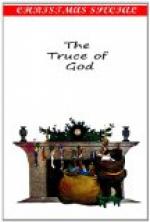of the Council of Elne, in the South of France, we
find that the “Truce of God,” the “Treuga
Dei” as it was technically called, was in
full honor and had reached the height of its beneficent
power in 1207. But long before, in the days when
Gregory VII was Pope, and William of Normandy had just
won his English crown, and Henry III ruled in Germany
and Henry I in France, in the days when feudalism
was making its first attempts to bring order out of
chaos, several councils of the Church in France and
in Normandy had traced out the plan and the outlines
of the “Truce of God.” Earlier even,
at the Councils of Charroux (989), Narbonne (990),
Le Puy and Anse (990), severe penalties were pronounced
against those who wantonly in time of war destroyed
the poor man’s cattle or harried his fields,
or carried off his beasts of burden. “Leagues
of Peace” were formed to diminish the horrors
of war, to protect the helpless, to enforce order.
The Council of Poitiers, where there is one of the
earliest mentions of these “Leagues of Peace,”
was held 1223 years ago. The Council of Bourges
in 1031 created a species of national militia to police
the rural districts and prevent war. Our ancestors
believed in leagues with “teeth in them.”
From France where the movement had its origin and
culminated at Elne (1207) in the full organization
of the “Truce of God,” it spread eastward
into Germany and Thuringia. The German duchies
and the Austrian marches submitted soon after to its
humanitarian and Christian code. In 1030, the
Pope, the French and German princes united their efforts
for the development of the forerunners of the “Truce
of God,” the conventions known as the “Peace
of God.” The Peace, the earlier institution
of the two, exempted from the evils of war, churches,
monasteries, clerics, children, pilgrims, husbandmen;
the cattle, the fields, the vineyards of the toiler;
his instruments of labor, his barns, his bakehouse,
his milch cows, his goats and his fowl. The Truce
forbade war at certain “closed seasons.”
It gave angry passions time to subside, and endeavored
to discredit war by making peace more desirable and
its blessings more prolonged. It is probable
that the Council of Charroux already mentioned laid
the germs of the Truce. At the Council of Elne
we see it fully organized. In 1139 the Tenth
General Council, the Second Lateran, gave in its eleventh
Canon its official approbation to what must be considered
one of the most beautiful institutions of the Middle
Ages.
Under the guidance of our American author, George Henry Miles, we are led back to the days of the eleventh century. He is an accurate and picturesque chronicler of that iron, yet chivalrous age. If on the one hand, we see the sinister figure of Henry IV of Germany, on the other we find the austere but noble monk Hildebrand, who became Pope St. Gregory VII. We hear the clash of swords drawn in private brawl and vendetta, but see them put back into the scabbard at the sound




